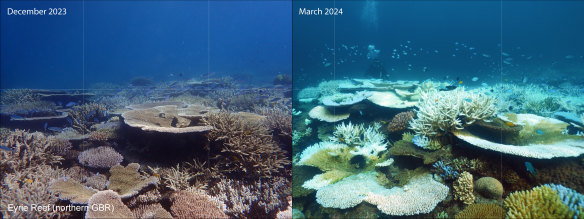The death toll from last summer’s coral bleaching event is starting to emerge, with underwater surveys confirming that more than one third of the corals on a cluster of reefs north of Cooktown were killed.
The Australian Marine Institute of Marine Science (AIMS) monitors the health of the entire stretch of the 2300-kilometre World Heritage ecosystem. It has today published the first results since last year’s marine heatwave caused coral bleaching up and down the reef, which found 31.4 per cent of the corals were killed on a section of the reef from Cooktown north to Lizard Island.

Before and after pictures show coral bleaching on Eyrie Reef in the northern Great Barrier Reef.Credit: Images courtesy of George Roff, CSIRO
“During February and March 2024, all the reefs we recently surveyed in this north Queensland region were subjected to levels of climate change-driven heat stress that cause bleaching,” said Mike Emslie, who leads the survey program.
“The heat stress got so high in some areas that mortality is not a surprising outcome. Tropical Cyclones Jasper and Kirrily also exposed many to wave heights likely to cause damage to corals, generally greater than four metres.”
Marine heatwaves drove mass coral bleaching on the reef in 2016, 2017, 2020, 2022 and 2024.
WWF Australia’s head of oceans Richard Leck said corals can bounce back from damage, but their resilience has limits.
“These initial surveys from AIMS are our worst fears from this year’s coral bleaching event being realised. It can’t get repeatedly hammered like this. We are fast approaching a tipping point.”
The surveys are ongoing and will be conducted on other sections of the reef.
